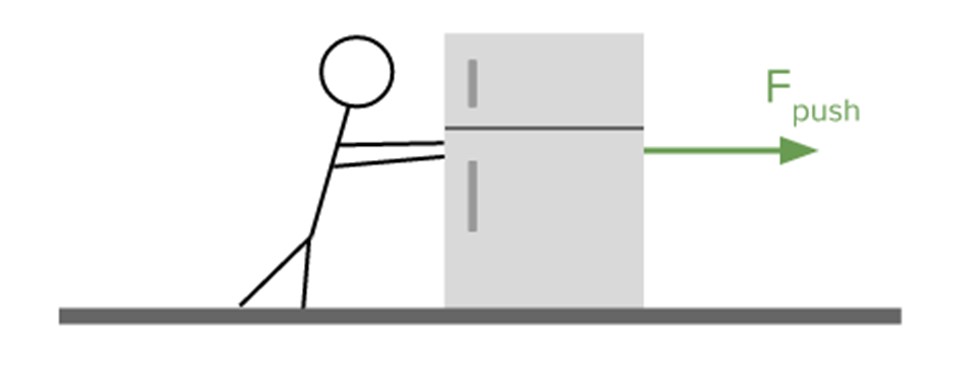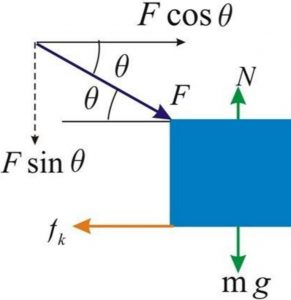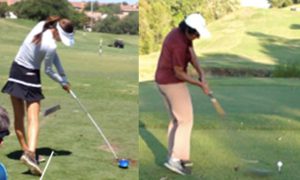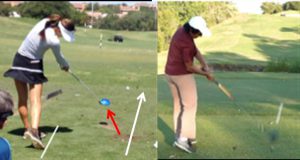The COSINE FACTOR
. How you can see majestic, high, straight flying golf shots that make your ball and heart soar . Understand how the direction of a pushing force is as important as the amount of the force . This is the first of a series of “what sense does it make” posts If you have to push a heavy refrigerator across the floor will you get directly behind it or stand at an angle to it? Stand directly behind it, of course! Would it make sense for you to stand at an angle to the refrigerator or push it from an angle other than the one you want it to move in? No. After all, you want to use all the force you are capable of producing towards moving the refrigerator in the direction you wish it to move. It is not only the amount of force you apply, but the angle at which you push an object, that matters. If you push while standing obliquely to the refrigerator, only a part of the force you intend to put into it actually goes into it! The diagram below is slightly mathematical, for the benefit of those who want to know more. The purple arrow is the direction of the force being applied, and the total force can be broken up into two components – the horizontal component which helps to push the refrigerator in a useful direction – forward – and the vertical one which is merely wasted. That horizontal component of the force is called the cosine of the force. [What multiplying the cosine of the angle at which the force is applied to the amount of force applied does, is that it multiples the force by a number from 0 to 1. When the angle is 0°, ie. the direction of push is along the intended direction of movement, the force applied is multiplied by one (the cosine of 0°). As the angle of application of push gets closer to perpendicular to the direction of desired movement, one multiplies the force by a smaller and smaller number, which indicates that less and less “useful force” which can actually help to move the object, is being applied to the refrigerator].
If you push while standing obliquely to the refrigerator, only a part of the force you intend to put into it actually goes into it! The diagram below is slightly mathematical, for the benefit of those who want to know more. The purple arrow is the direction of the force being applied, and the total force can be broken up into two components – the horizontal component which helps to push the refrigerator in a useful direction – forward – and the vertical one which is merely wasted. That horizontal component of the force is called the cosine of the force. [What multiplying the cosine of the angle at which the force is applied to the amount of force applied does, is that it multiples the force by a number from 0 to 1. When the angle is 0°, ie. the direction of push is along the intended direction of movement, the force applied is multiplied by one (the cosine of 0°). As the angle of application of push gets closer to perpendicular to the direction of desired movement, one multiplies the force by a smaller and smaller number, which indicates that less and less “useful force” which can actually help to move the object, is being applied to the refrigerator].  That is exactly what is happening in golf – all golfers’ clubs (regardless of whether they are skilled and professional or merely weekend warriors) move way inside the target line after impact. That happens regardless of whether the club approached the ball from the outside or the inside. Just stand behind any golfer at a driving range to see what I mean! When the club moves way inside the target line past impact, the golfer is only applying a portion of the force intended for the ball into it - and the rest into the ground or the air around the ball (hence the ant joke where one ant tells the other the safest place to remain uninjured from while a golfer swings is the top of the ball!).
That is exactly what is happening in golf – all golfers’ clubs (regardless of whether they are skilled and professional or merely weekend warriors) move way inside the target line after impact. That happens regardless of whether the club approached the ball from the outside or the inside. Just stand behind any golfer at a driving range to see what I mean! When the club moves way inside the target line past impact, the golfer is only applying a portion of the force intended for the ball into it - and the rest into the ground or the air around the ball (hence the ant joke where one ant tells the other the safest place to remain uninjured from while a golfer swings is the top of the ball!).  But, you might argue, the ball goes straight, so why worry? Well if you hit the ball as far as you’d like with no sideways movement, that is certainly true. Neither the club moving off at an angle sideways (as illustrated above), nor upwards (and causing a thin shot) will matter, because you do not need any further directional or trajectory-related improvements. If however, you, like the rest of us non-Herculean humans want the maximum distance you can extract from every shot, and need the higher trajectory which aids maximal distance, your swing needs to change from a “what sense does that make” type of swing. In the typical “what sense does that make” swing, not only do the hips rotate too early, but so too does the torso, and that is what pulls the shoulders and arms “in” too early too. The Minimalist Golf Swing, on the other hand, starts the golfer with a pre-swing rotation of the pelvis and torso away from target, so that the golfer’s hips during the downswing move from way-closed to square. The shoulders which always lag behind the hips, are therefore barely square at impact, and so too, then, are the arms. The club is thus able to move along the target line a fraction of a second longer than otherwise, before the torso’s inevitable rotation pulls it inside the target line again. Compare the impact positions of the most athletic female golfer and an average one, below. The golfer on the left has both her hips and shoulders open to the target. In the picture on the right, the golfer’s shoulders have just reached square while the hips are slightly open to the target line. Note that because of the MGS pre-swing torso rotation “closed” to the target line, the hips have rotated a long way, just in a different – and better – direction.
But, you might argue, the ball goes straight, so why worry? Well if you hit the ball as far as you’d like with no sideways movement, that is certainly true. Neither the club moving off at an angle sideways (as illustrated above), nor upwards (and causing a thin shot) will matter, because you do not need any further directional or trajectory-related improvements. If however, you, like the rest of us non-Herculean humans want the maximum distance you can extract from every shot, and need the higher trajectory which aids maximal distance, your swing needs to change from a “what sense does that make” type of swing. In the typical “what sense does that make” swing, not only do the hips rotate too early, but so too does the torso, and that is what pulls the shoulders and arms “in” too early too. The Minimalist Golf Swing, on the other hand, starts the golfer with a pre-swing rotation of the pelvis and torso away from target, so that the golfer’s hips during the downswing move from way-closed to square. The shoulders which always lag behind the hips, are therefore barely square at impact, and so too, then, are the arms. The club is thus able to move along the target line a fraction of a second longer than otherwise, before the torso’s inevitable rotation pulls it inside the target line again. Compare the impact positions of the most athletic female golfer and an average one, below. The golfer on the left has both her hips and shoulders open to the target. In the picture on the right, the golfer’s shoulders have just reached square while the hips are slightly open to the target line. Note that because of the MGS pre-swing torso rotation “closed” to the target line, the hips have rotated a long way, just in a different – and better – direction.  In any golf swing, as soon as the downswing is initiated, the strongly stretched core muscles begin a rotation, much like a coiled spring does as soon as it is released. The trick is to find a way to make that rotation help rather than hinder impact. The only useful solution is to set up so that the powerfully rotating pelvis and torso are just slightly open, while the lagging shoulders are square or closed, so that the club is able to move along the target line for a mere fraction of a second, rather than drastically inside.
In any golf swing, as soon as the downswing is initiated, the strongly stretched core muscles begin a rotation, much like a coiled spring does as soon as it is released. The trick is to find a way to make that rotation help rather than hinder impact. The only useful solution is to set up so that the powerfully rotating pelvis and torso are just slightly open, while the lagging shoulders are square or closed, so that the club is able to move along the target line for a mere fraction of a second, rather than drastically inside.  The body positions associated with the “cosine factor” has many implications for injury too, as research shows that slight compression (from forward bending) combined with side-bending and rotation can cause a wide variety of spinal injuries.
The body positions associated with the “cosine factor” has many implications for injury too, as research shows that slight compression (from forward bending) combined with side-bending and rotation can cause a wide variety of spinal injuries. 